Researchers at the University of Florida, led by Aditya Varanwal and including Parin Shah, George Carrion, Ashley Ortenburg, Diego Ramirez-Gomez, Chris Vermillion, and Andre P. Mazzoleni, have developed an innovative robotic platform designed to meet the growing demand for sustainable and persistent robotic systems in various fields, including military surveillance. Their creation, the Spherical Sailing Omnidirectional Rover (SSailOR), is a wind-powered autonomous rover that promises to revolutionize long-duration mobility with minimal energy consumption.
The SSailOR’s design is driven by the need for robust, adaptable robotic systems capable of operating in harsh environments, such as planetary surfaces, Arctic regions, and remote military outposts. The rover’s spherical shape is a key innovation, simplifying mechanical complexity while enabling omnidirectional movement. This design allows the SSailOR to navigate challenging terrains and adapt to changing environmental conditions with ease. The rover’s wind propulsion system, powered by onboard sails, ensures continuous mobility without the need for frequent recharging or refueling, making it an ideal candidate for long-term surveillance and exploration missions.
To validate the SSailOR’s dynamic models and assess its aerodynamic performance, the researchers conducted a series of controlled experiments in a wind tunnel. The experimental setup included a detailed mechanical structure, sensor integration, electronics, and a data acquisition system. The tests were designed to evaluate the rover’s performance under various configurations and environmental conditions. The results of these experiments provided valuable insights into the SSailOR’s aerodynamic characteristics and highlighted areas for design optimization.
One of the key findings of the study was the importance of a co-design approach in the development of the SSailOR. This approach involves the simultaneous consideration of multiple design aspects, such as aerodynamics, mechanical structure, and sensor integration, to ensure optimal performance. The researchers observed that the SSailOR’s performance was significantly influenced by the interaction between these different design elements, emphasizing the need for a holistic approach to rover development.
The practical applications of the SSailOR in the defence and security sector are numerous. Its ability to operate autonomously for extended periods makes it an ideal platform for long-term surveillance and reconnaissance missions. The rover’s omnidirectional movement and adaptability to harsh environments enable it to navigate and monitor remote and inaccessible areas, providing valuable intelligence for military operations. Additionally, the SSailOR’s minimal energy consumption and sustainable design make it an environmentally friendly option for military applications, reducing the logistical burden and environmental impact of traditional robotic systems.
In conclusion, the development of the SSailOR represents a significant advancement in the field of robotic systems for defence and security applications. The innovative design and wind-powered propulsion system of the SSailOR offer a sustainable and adaptable solution for long-duration mobility in challenging environments. The insights gained from the wind tunnel experiments will guide further development and optimization of the rover, paving the way for its deployment in real-world military and exploration scenarios.
This article is based on research available at arXiv.

